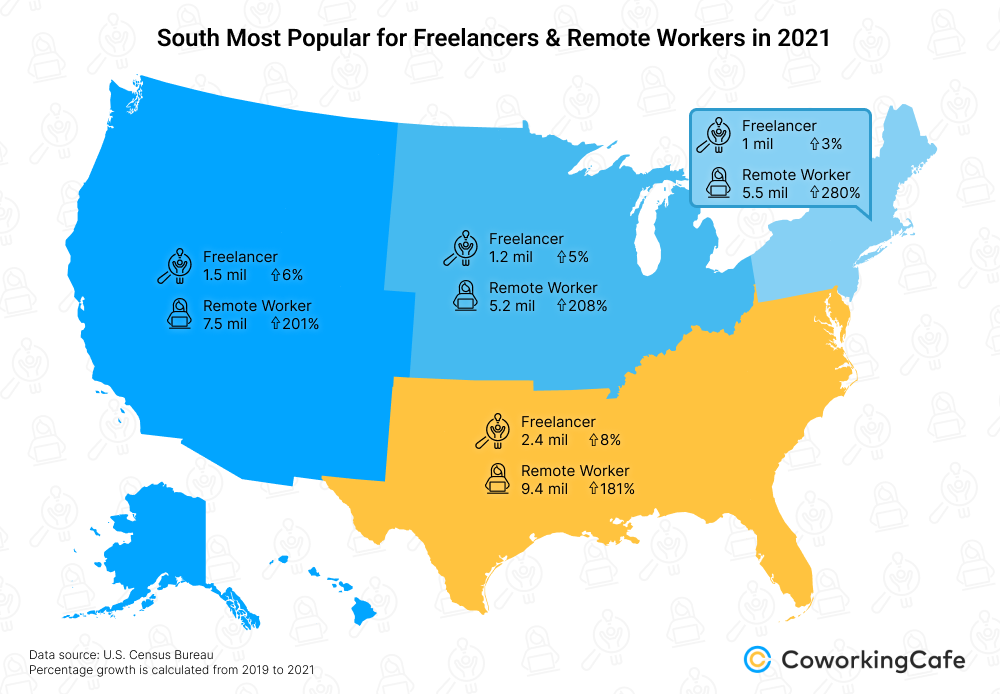Key Takeaways:
- Despite witnessing a significant rise in the share of self-employed workers, most cities across the nation are underserved in terms of coworking spaces, with an average of just three flexible workspaces per 1,000 freelancers.
- The number of freelancers has grown by more than 50% in Newark, NJ; Stockton, CA; and Nashville, TN.
- The highest number of coworking spaces per 1,000 freelancers was logged in Pittsburgh, PA.
- In the last three years, the increases in both freelancers and remote workers was most significant in the Southern and Western regions.
Flexible schedules, remote locations and self-management — these were always solid reasons for choosing the freelancer lifestyle, but, in the context of the pandemic, they became even more enticing for workers everywhere.
A trend that was already on an upward trajectory since 2010, the rise of self-employed workers reached new heights in 2021 with more than 6 million freelancers operating across the U.S. and a 6% year-over-year growth in the last three years. At the same time, the dramatic increase in working from home (WFH) that was initially enforced by COVID-19 regulations, has quickly transitioned into the new norm for many businesses. In fact, in 2021, that translated into 27 million remote workers — a whopping 207% growth in the last three years.
Accordingly, the growth in flexible space was also significant. JLL reported that flexible workspaces accounted for roughly 12 million square feet across the nation in 2010. And now, CommercialEdge data from September 2022 shows that coworking spaces cover more than 120 million square feet across 5,800 locations in the U.S. — a clear sign that increasing demand for coworking spaces is motivating operators, owners and developers to consider adding flexible workspaces to their portfolios.
Meanwhile, some cities — like Newark, NJ; Stockton, CA; and Nashville, TN — registered total changes of over 50% in the number of freelancers from 2019 to 2021. Perhaps surprisingly, other U.S. locations (such as San Francisco and Santa Ana, CA; Las Vegas, NV; or Boston, MA) witnessed negative changes in their number of self-employed workers in the same time period.
Considering these shifts, we wanted to determine exactly how many coworking spaces freelancers have at their disposal in the top U.S. cities that saw the most significant changes in freelancers in the last three years. As such, we calculated the number of coworking spaces per 1,000 freelancers in cities with populations higher than 300,000 and where freelancing has grown the most.
Freelancing on the Rise, But Coworking Spaces Falling Short in Many Trending Cities
The highest growth among freelancers between 2019 and 2021 was recorded in Newark, NJ, which increased 85%. However, the city is underserved by the coworking market, as it only checks two coworking spaces per 1,000 freelancers. This means that self-employed workers here don’t have many options to choose from if they want to use a flexible workspace. Similarly , Riverside, CA; Honolulu; and Fort Worth, TX, also provide just two coworking spaces per 1,000 self-employed workers.
In Honolulu, the shortage of coworking spaces is even more relevant. Here, freelancers make up more than 4% of the total workforce (higher than the 3% average of all of the cities we analyzed). In fact, 2022 Census data revealed that superstar cities across the nation are losing ground in favor of mid- or smaller-sized areas, as a result of the migration set in motion by COVID-19 and the lifestyle changes brought about by the WFH trend. As such, it’s likely that many freelancers are choosing to work from sunny Hawaii in order to combine business and leisure and achieve the proverbial work/life balance. Yet, despite the demand, flexible working spaces are still lagging in this area, with only two per 1,000 freelancers.
Back on the mainland, Midwestern cities such as Indianapolis, IN; Nashville, TN; and Milwaukee, WI, each averaged three coworking spaces per 1,000 freelancers, a slight improvement compared to the previous locations. And, among the top 20 cities that registered high increases in their numbers of freelancers, Cincinnati is the only one that offers seven coworking spaces per 1,000 self-employed workers, likely due to its thriving business scene. Dallas, TX and Cleveland, OH, follow behind, with four such spaces each.
Likewise, Stockton, CA; Omaha, NE; Anaheim, CA; and El Paso, TX, are also severely underserved by the coworking field, as 1,000 freelancers in each of these cities can choose to cowork in only one flexible space. And, despite the fact that the number of freelancers in all of these locations grew by more than 27% during the last three years, it appears that coworking spaces have yet to breach the market and truly rise up to the demand from this demographic.
Freelancers in Pittsburgh, PA & Irvine, CA, Have More Coworking Space Options than Other Trending Cities
At the other end of the spectrum, we have Pittsburgh, PA. Despite seeing a significant decrease of 10% in its number of freelancers, the city provides the highest number of coworking spaces on our list — 12 per 1,000 freelancers. At the same time, less than 2% of the total employed population in Pittsburgh were freelancers in 2021. Even so, it’s important to note that, as of last year, the number of remote workers in this area increased more than 300% compared to 34,000 workers — likely driving the demand for flexible workspaces.
Similarly, freelancers in Irvine, CA can also pick and choose their preferred coworking location from the 11 available per 1,000 freelancers. That indicates a larger supply even for a demographic that appears to be on a downward trajectory in this area, as the number of freelance workers in Irvine has decreased by 15% in 2021.
The number of remote workers has also grown significantly in the nation’s capital: in Washington, D.C., more than 142,000 more people worked from home in 2021 compared to 2019 — one of the highest changes registered nationwide and an increase of more than 500%. And, while the city claims nine coworking spaces per 1,000 freelancers, the negligible change in its number (less than 1% in the last three years), concludes that the coworking segment in Washington, D.C. is mostly driven by remote workers , startups or entrepreneurs, as opposed to self-employed freelancers.
Southern & Western Regions Claim Highest Numbers of Both Freelancers & Remote Workers in 2021

According to Census data, there were more than 6 million freelancers in the United States in 2021 — 2.3 million of whom were in the South, with another 1.5 million in the Western region. The same goes for remote workers, who spent another year working from home or a third-party location: of the 27 million total across the nation, more than 9.3 million were operating from the South, while 7.5 million worked remotely in Western cities.
These main regions were led by major tech hubs like California and Texas, which checked the most cities among the top 20 places where the number of freelancers has grown the most between 2019 and 2021. Specifically, California cities like Stockton, Riverside and Oakland made the top five cities with the highest increases in freelancers with total changes of 68%, 48% and 47%, respectively. Similarly, Texas’ lack of income tax — as well as its more affordable cost of living — makes it a desirable state to be in as a self-employed worker. As such, Dallas, Fort Worth and El Paso, TX, are also present in the top 20 cities with the most growth in terms of freelancers, boosting Texas’ appeal as an ever-growing haven for businesses.
Expert Insights

To get even more insights into the topic of freelancer growth, we talked to Blogger and Internet Marketer Erik Emanuelli. Here’s what he was to say in response to our questions:
What would you say are the main factors that make a city attractive for freelancers?
- Cost of living. One of the most important factors in assessing a city’s attractiveness for freelancers is the cost of living. Generally speaking, cities with lower costs of living are more attractive to freelancers because they can stretch their income further and still enjoy a high quality of life.
- Availability of coworking spaces. Coworking spaces are becoming increasingly popular among freelancers as they provide a professional environment to work in, while also allowing access to amenities and facilities that may not be available at home. If a city has plenty of coworking options, it will be more attractive for freelancers.
- Networking opportunities. Freelancers need to be able to build relationships and network with other professionals in order to grow their businesses. Cities that have a thriving freelancer community, or offer opportunities for networking, can be attractive to freelancers who want to build their businesses.
- Accessible transportation. In order to take advantage of the networking opportunities available, freelancers need to be able to get around easily and quickly. Thus, cities with efficient public transportation systems or other accessible transit options can be attractive for freelancers.
- Quality of life. Last but not least, quality of life is also an important factor in assessing the attractiveness of a city for freelancers. After all, freelancers need to be able to enjoy their free time, and cities that offer plenty of activities, culture, and entertainment can be very attractive for freelancers.
Do you think coworking spaces are attractive for freelancers or remote workers? Why is that?
Yes, coworking spaces are attractive for freelancers and remote workers because they provide a professional environment to work in as well as access to amenities and resources that may not be available at home. Moreover, coworking spaces also offer the opportunity to collaborate with other professionals and build relationships that can help to grow their business. Finally, coworking spaces often provide a supportive and creative environment, which can be beneficial for freelancers and remote workers who may otherwise be working in isolation.
Methodology
- To determine the cities with the greatest changes in numbers of freelancers, we focused on metro areas with populations of more than 300,000.
- The square footage growth in coworking spaces between 2010 and 2017 was determined by JLL data.
- The calculation of self-employed workers and remote workers in 2019 and 2021 was based on data from the U.S. Census Bureau. The same applied to the employed population and the share of freelancers from the total workforce.
- Data from the Census and our sister division, CommercialEdge, was used to determine the number of coworking spaces per 1,000 freelancers.







